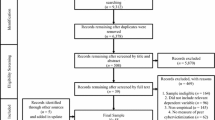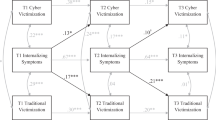Abstract
Cyberbullying (perpetration and victimization) is a prevalent public health problem associated with a wide variety of psychopathological symptoms (e.g., depression, anxiety, delinquent behaviors, and substance use). However, the generality and specificity of relations between cyberbullying involvement and psychopathological symptoms have not been investigated. Thus, the current study used a latent dimensional approach to examine how cyberbullying (perpetration and victimization) is associated with underlying dimensions of psychopathology as well as with specific symptoms. General and specific associations were estimated by a series of structural equation models with data from 654 Chinese adolescents (52.4% girls, Mage = 12.96 years, SD = 0.67) in a three-wave study. Results indicated that cyberbullying (perpetration and victimization) was significantly and positively associated with latent internalizing and externalizing dimensions. Cyberbullying involvement was non-significantly associated with most specific symptom domains after accounting for the impact of the latent internalizing and externalizing factors. In a few cases, cyberbullying involvement was directly and uniquely associated with specific symptoms. Findings of significant general and symptom-specific associations have important implications for efforts to develop more efficient and targeted strategies for preventing and treating mental health problems associated with cyberbullying.

Similar content being viewed by others
Data availability
Our study is not able to share data and relevant materials publicly because our data derive from an ongoing scientific research project supporting by National Natural Science Foundation of China. Because the survey data involve users’ privacy and confidentiality issues, we have signed confidentiality agreements with the data providers, that is, relevant middle school boards.
References
Kowalski RM, Giumetti GW, Schroeder AN, Lattanner MR (2014) Bullying in the digital age: a critical review and meta-analysis of cyberbullying research among youth. Psychol Bull 140:1073–1137. https://doi.org/10.1037/a0035618
Tokunaga RS (2010) Following you home from school: a critical review and synthesis of research on cyberbullying victimization. Comput Hum Behav 26:277–287. https://doi.org/10.1016/j.chb.2009.11.014
Fisher BW, Gardella JH, Teurbe-Tolon AR (2016) Peer cybervictimization among adolescents and the associated internalizing and externalizing problems: a meta-analysis. J Youth Adolesc 45:1727–1743. https://doi.org/10.1007/s10964-016-0541-z
Camerini AL, Marciano L, Carrara A, Schulz PJ (2020) Cyberbullying perpetration and victimization among children and adolescents: a systematic review of longitudinal studies. Telemat Inform 49:101362. https://doi.org/10.1016/j.tele.2020.101362
Marciano L, Schulz PJ, Camerini AL (2020) Cyberbullying perpetration and victimization in youth: a meta-analysis of longitudinal studies. J Comput-Mediat Commun 25:163–181. https://doi.org/10.1093/jcmc/zmz031
Li Q (2007) New bottle but old wine: a research of cyberbullying in schools. Comput Hum Behav 23:1777–1791. https://doi.org/10.1016/j.chb.2005.10.005
Ormel J, Raven D, van Oort F, Hartman CA, Reijneveld SA, Veenstra R, Oldehinkel AJ (2015) Mental health in Dutch adolescents: a TRAILS report on prevalence, severity, age of onset, continuity and co-morbidity of DSM disorders. Psychol Med 45:345–360. https://doi.org/10.1017/S0033291714001469
American Psychiatric Association (2013) Diagnostic and statistical manual of mental disorders, 5th edn. American Psychiatric Publishing, Washington, DC
Fahy AE, Stansfeld SA, Smuk M, Smith NR, Cummins S, Clark C (2016) Longitudinal associations between cyberbullying involvement and adolescent mental health. J Adolesc Health 59:502–509. https://doi.org/10.1016/j.jadohealth.2016.06.006
Tian L, Yan Y, Huebner ES (2018) Effects of cyberbullying and cybervictimization on early adolescents’ mental health: differential mediating roles of perceived peer relationship stress. Cyberpsychology Behav Soc Netw 21:429–436. https://doi.org/10.1089/cyber.2017.0735
Kessler RC, Cox BJ, Green JG, Ormel J, McLaughlin KA, Merikangas KR, Zaslavsky AM (2011) The effects of latent variables in the development of comorbidity among common mental disorders. Depress Anxiety 28:29–39. https://doi.org/10.1002/da.20760
Krueger RF (1999) The structure of common mental disorders. Arch Gen Psychiatry 56:921–926. https://doi.org/10.1001/archpsyc.56.10.921
Forbes MK, Magson NR, Rapee RM (2020) Evidence that different types of peer victimization have equivalent associations with transdiagnostic psychopathology in adolescence. J Youth Adolesc 49:590–604. https://doi.org/10.1007/s10964-020-01202-4
Conway CC, Raposa EB, Hammen C, Brennan PA (2018) Transdiagnostic pathways from early social stress to psychopathology: a 20-year prospective study. J Child Psychol Psychiatry 59:855–862. https://doi.org/10.1111/jcpp.12862
Keyes KM, Eaton NR, Krueger RF, McLaughlin KA, Wall MM, Grant BF, Hasin DS (2012) Childhood maltreatment and the structure of common psychiatric disorders. Br J Psychiatry 200:107–115. https://doi.org/10.1192/bjp.bp.111.093062
Schaefer JD, Moffitt TE, Arseneault L, Danese A, Fisher HL, Houts R, Caspi A (2018) Adolescent victimization and early-adult psychopathology: Approaching causal inference using a longitudinal twin study to rule out noncausal explanations. Clin Psychol Sci 6:352–371. https://doi.org/10.1177/2167702617741381
Holfeld B, Leadbeater BJ (2018) The interrelated effects of traditional and cybervictimization on the development of internalizing symptoms and aggressive behaviors in elementary school. Merrill-Palmer Q 64:220–247. https://doi.org/10.13110/merrpalmquar1982.64.2.0220
Holfeld B, Mishna F (2019) Internalizing symptoms and externalizing problems: risk factors for or consequences of cyber victimization? J Youth Adolesc 48:567–580. https://doi.org/10.1007/s10964-018-0974-7
Kim S, Colwell SR, Kata A, Boyle MH, Georgiades K (2018) Cyberbullying victimization and adolescent mental health: evidence of differential effects by sex and mental health problem type. J Youth Adolesc 47:661–672. https://doi.org/10.1007/s10964-017-0678-4
Forbes MK, Fitzpatrick S, Magson NR, Rapee RM (2019) Depression, anxiety, and peer victimization: bidirectional relationships and associated outcomes transitioning from childhood to adolescence. J Youth Adolesc 48:692–702. https://doi.org/10.1007/s10964-018-0922-6
Little RJ (1988) A test of missing completely at random for multivariate data with missing values. J Am Stat Assoc 83:1198–1202. https://doi.org/10.1080/01621459.1988.10478722
Bollen KA (1989) A new incremental fit index for general structural equation models. Sociol Methods Res 17:303–316. https://doi.org/10.1177/0049124189017003004
Moore PM, Huebner ES, Hills KJ (2012) Electronic bullying and victimization and life satisfaction in middle school students. Soc Indic Res 107:429–447. https://doi.org/10.1007/s11205-011-9856-z
Russell DW (1996) UCLA Loneliness Scale (Version 3): reliability, validity, and factor structure. J Pers Assess 66:20–40. https://doi.org/10.1207/s15327752jpa6601_2
Zhu X, Huebner ES, Tian L (2019) A person-centered longitudinal analysis of adolescents’ loneliness and social anxiety: Clusters, predictors, and outcomes. School Psychol 34:576–589. https://doi.org/10.1037/spq0000328
Birleson P (1981) The validity of depressive disorder in childhood and the development of a self-rating scale: a research report. J Child Psychol Psychiatry 22:73–88. https://doi.org/10.1111/j.1469-7610.1981.tb00533.x
Birmaher B, Khetarpal S, Brent D, Cully M, Balach L, Kaufman J, Neer SM (1997) The screen for child anxiety related emotional disorders (SCARED): scale construction and psychometric characteristics. J Am Acad Child Adolesc Psychiatr 36:545–553. https://doi.org/10.1097/00004583-199704000-00018
Guo L, Tian L, Huebner ES (2018) Family dysfunction and anxiety in adolescents: a moderated mediation model of self-esteem and perceived school stress. J Sch Psychol 69:16–27. https://doi.org/10.1016/j.jsp.2018.04.002
Zhang W, Du D, Zhen S, Warren AEA, Lerner RM, Phelps E (2011) Belief systems and positive youth development among Chinese and American youth. In: Warren AEA, Lerner RM, Phelps E (eds) Thriving and spirituality among youth: Research perspectives and future possibilities. John Wiley & Sons Inc, Hoboken, pp 309–331
Yu C, Zhang W, Zeng Y, Ye T, Li Y, Wang S (2011) Relationship between adolescents’ gratitude and problem behavior: the mediating role of school connectedness. Psychol Dev Educ 27:425–433. https://doi.org/10.16187/j.cnki.issn1001-4918.2011.04.003
Sjursø IR, Fandrem H, Roland E (2016) Emotional problems in traditional and cyber victimization. J Sch Violence 15:114–131. https://doi.org/10.1080/15388220.2014.996718
Campbell M, Spears B, Slee P, Butler D, Kift S (2012) Victims’ perceptions of traditional and cyberbullying, and the psychosocial correlates of their victimisation. Emot Behav Diffic 17:389–401. https://doi.org/10.1080/13632752.2012.704316
Broll R, Dunlop C, Crooks CV (2018) Cyberbullying and internalizing difficulties among Indigenous adolescents in Canada: beyond the effect of traditional bullying. J Child Adolesc Trauma 11:71–79. https://doi.org/10.1007/s40653-017-0163-y
Lahey BB, Krueger RF, Rathouz PJ, Waldman ID, Zald DH (2017) A hierarchical causal taxonomy of psychopathology across the life span. Psychol Bull 143:142–186
Takizawa R, Maughan B, Arseneault L (2014) Adult health outcomes of childhood bullying victimization: evidence from a five-decade longitudinal British birth cohort. Am J Psychiat 171:777–784. https://doi.org/10.1176/appi.ajp.2014.13101401
Polanin JR, Espelage DL, Grotpeter JK, Ingram K, Michaelson L, Spinney E, Robinson L (2022) A systematic review and meta-analysis of interventions to decrease cyberbullying perpetration and victimization. Prev Sci 23:439–454. https://doi.org/10.1007/s11121-021-01259-y
Mishna F, Cook C, Gadalla T, Daciuk J, Solomon S (2010) Cyber bullying behaviors among middle and high school students. Am J Orthopsychiatr 80:362–374. https://doi.org/10.1111/j.1939-0025.2010.01040.x
Hemphill SA, Kotevski A, Heerde JA (2015) Longitudinal associations between cyber-bullying perpetration and victimization and problem behavior and mental health problems in young Australians. Int J Public Health 60:227–237. https://doi.org/10.1007/s00038-014-0644-9
Schoeler T, Duncan L, Cecil CM, Ploubidis GB, Pingault JB (2018) Quasi-experimental evidence on short-and long-term consequences of bullying victimization: a meta-analysis. Psychol Bull 144:1229–1246. https://doi.org/10.1037/bul0000171
Singham T, Viding E, Schoeler T, Arseneault L, Ronald A, Cecil CM, Pingault JB (2017) Concurrent and longitudinal contribution of exposure to bullying in childhood to mental health: the role of vulnerability and resilience. JAMA Psychiat 74:1112–1119. https://doi.org/10.1001/jamapsychiatry.2017.2678
Holfeld B, Baitz R (2020) The mediating and moderating effects of social support and school climate on the association between cyber victimization and internalizing symptoms. J Youth Adolesc 49:2214–2228. https://doi.org/10.1007/s10964-020-01292-0
Sampasa-Kanyinga H, Lalande K, Colman I (2020) Cyberbullying victimisation and internalising and externalising problems among adolescents: the moderating role of parent-child relationship and child’s sex. Epidemiol Psychiatr Sci 29:1–10. https://doi.org/10.1017/S2045796018000653
Funding
This work was supported by the National Natural Science Foundation of China (No. 31971005), Guangdong Basic and Applied Basic Research Foundation (No. 2021A1515012515), Guangdong Basic and Applied Basic Research Foundation (No. 2022A1515011233), “14th Five-Year” Plan of Philosophy and Social Science Development in Guangzhou City, 2022 (No. 2022GZGJ175), and Philosophy and Social Science Planning Project in Guangdong Province, 2022 (No. GD22CXL03).
Author information
Authors and Affiliations
Corresponding author
Ethics declarations
Conflict of interest
On behalf of all authors, the corresponding author states that there is no conflict of interest.
Ethical approval
All procedures performed in studies involving human participants were in accordance with the ethical standards of the institutional research committee (School of Psychology Research Ethics Committee, South China Normal University) and with the 1964 Helsinki declaration and its later amendments or comparable ethical standards.
Supplementary Information
Below is the link to the electronic supplementary material.
Rights and permissions
Springer Nature or its licensor (e.g. a society or other partner) holds exclusive rights to this article under a publishing agreement with the author(s) or other rightsholder(s); author self-archiving of the accepted manuscript version of this article is solely governed by the terms of such publishing agreement and applicable law.
About this article
Cite this article
Xu, X., Yang, C., Huebner, E.S. et al. Understanding general and specific associations between cyberbullying and psychopathological symptoms in adolescents: a latent dimensional approach. Eur Child Adolesc Psychiatry 33, 749–759 (2024). https://doi.org/10.1007/s00787-023-02198-5
Received:
Accepted:
Published:
Issue Date:
DOI: https://doi.org/10.1007/s00787-023-02198-5




